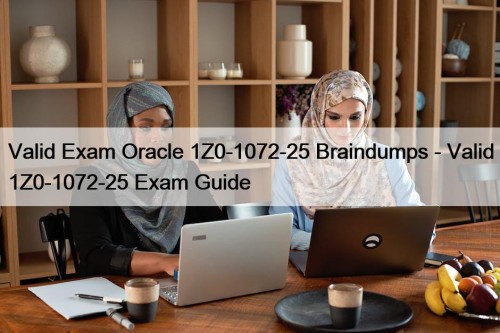Most Popular
 Valid Exam Oracle 1Z0-1072-25 Braindumps - Valid 1Z0-1072-25 Exam Guide
Valid Exam Oracle 1Z0-1072-25 Braindumps - Valid 1Z0-1072-25 Exam Guide
In order to meet the demand of all customers and ...
 Useful ISO-14001-Lead-Auditor - PECB Certified EMS ISO 14001 Lead Auditor Exam Test Labs
Useful ISO-14001-Lead-Auditor - PECB Certified EMS ISO 14001 Lead Auditor Exam Test Labs
Over the past few years, we have gathered hundreds of ...
 Updated NVIDIA NCP-AII Exam Question Offer You The Best New Test Notes | NVIDIA AI Infrastructure
Updated NVIDIA NCP-AII Exam Question Offer You The Best New Test Notes | NVIDIA AI Infrastructure
Our team of professionals and experts has prepared NCP-AII vce ...



1Z0-1151-25 Exam Braindumps, Exam 1Z0-1151-25 Simulator

Oracle Cloud Infrastructure 2025 Multicloud Architect Professional study questions provide free trial service for consumers. If you are interested in 1Z0-1151-25 exam material, you only need to enter our official website, and you can immediately download and experience our trial PDF file for free. Through the trial you will have different learning experience, you will find that what we say is not a lie, and you will immediately fall in love with our products. As a key to the success of your life, the benefits that 1Z0-1151-25 Exam Guide can bring you are not measured by money. 1Z0-1151-25 exam guide can not only help you pass the exam, but also help you master a new set of learning methods and teach you how to study efficiently, 1Z0-1151-25 exam material will lead you to success.
Oracle 1Z0-1151-25 Exam Syllabus Topics:
| Topic | Details |
|---|---|
| Topic 1 |
|
| Topic 2 |
|
| Topic 3 |
|
| Topic 4 |
|
| Topic 5 |
|
>> 1Z0-1151-25 Exam Braindumps <<
100% Pass Quiz 2025 Updated Oracle 1Z0-1151-25: Oracle Cloud Infrastructure 2025 Multicloud Architect Professional Exam Braindumps
Today is the best time to become competitive and updated in the market. You can do this easily. Just enroll in the 1Z0-1151-25 exam and start 1Z0-1151-25 exam preparation with Oracle Cloud Infrastructure 2025 Multicloud Architect Professional exam dumps. Download the Exams. Solutions Oracle 1Z0-1151-25 Exam Dumps after paying an affordable 1Z0-1151-25 exam questions charge and start this journey without wasting further time.
Oracle Cloud Infrastructure 2025 Multicloud Architect Professional Sample Questions (Q40-Q45):
NEW QUESTION # 40
Which of the following is NOT a requirement for establishing Oracle Interconnect for Google Cloud?
- A. A Partner Interconnect connection in Google Cloud.
- B. A Cloud Router in Google Cloud.
- C. A Shared VPC between OCI and Google Cloud.
- D. A FastConnect virtual circuit in OCI.
Answer: C
Explanation:
A Shared VPC is a Google Cloud concept that allows multiple projects within an organization to share a common Virtual Private Cloud (VPC) network. It's not a requirement for establishing Oracle Interconnect for Google Cloud. The interconnect focuses on connecting the networks at a higher level, between the OCI VCN and the Google Cloud VPC, regardless of whether Shared VPC is used within the Google Cloud organization.
The other options are required:
A). A FastConnect virtual circuit in OCI: This provides the OCI-side connection point for the Interconnect.
B). A Partner Interconnect connection in Google Cloud: This is the common method for establishing the physical or virtual connection between the two cloud providers, leveraging a third-party partner. (Dedicated Interconnect is an alternative for very high bandwidth needs).
D). A Cloud Router in Google Cloud: This is necessary for establishing BGP peering with the OCI DRG, enabling dynamic routing between the two environments
NEW QUESTION # 41
Suppose you have a highly sensitive dataset stored in an Autonomous Database. What is the BEST way to ensure that no data leaves the EU?
- A. Select an EU region for your Autonomous Database deployment and enable customer-managed encryption keys.
- B. Use Data Masking to obfuscate sensitive data before it leaves the database.
- C. Implement Transparent Data Encryption (TDE) with a customer-managed key.
- D. Configure a Virtual Cloud Network (VCN) with a security list blocking all outbound traffic.
Answer: A
Explanation:
Here's why:
EU Region Selection: Deploying the Autonomous Database in an EU region (e.g., Frankfurt, Amsterdam, Paris, Dublin) ensures that the data physically resides within the EU's geographical boundaries. This addresses data residency requirements directly.
Customer-Managed Encryption Keys (CMEK): Enabling CMEK gives you control over the encryption keys used to protect your data at rest. This provides an additional layer of security and helps you meet compliance requirements related to key management. It also ensures that even if someone were to somehow exfiltrate the encrypted data, they wouldn't be able to decrypt it without your keys, which reside in your control, presumably also within the EU.
Why the other options are less suitable:
a) Configure a Virtual Cloud Network (VCN) with a security list blocking all outbound traffic: While blocking all outbound traffic would prevent data from leaving the VCN, it would also make the database practically unusable. Applications and users would not be able to connect to it. This is an overly restrictive and impractical solution.
b) Use Data Masking to obfuscate sensitive data before it leaves the database: Data masking is useful for protecting sensitive data when it needs to be shared with non-production environments or third parties. However, it doesn't prevent data from leaving the EU. The masked data would still be subject to data residency regulations.
d) Implement Transparent Data Encryption (TDE) with a customer-managed key: TDE encrypts data at rest, which is a good security practice. Having a customer-managed key adds further control. However, TDE alone does not guarantee data residency. The data could still be stored in a non-EU region.
NEW QUESTION # 42
Which workload type is NOT optimized for Oracle Autonomous Database on Shared Exadata Infrastructure?
- A. Data warehousing
- B. High-performance computing
- C. Mixed workloads
- D. Transaction processing
Answer: B
Explanation:
Oracle Autonomous Database on Shared Exadata Infrastructure is optimized for data warehousing (Option A), mixed workloads (Option B), and transaction processing (Option D), leveraging Exadata's performance and automation. High-performance computing (HPC, Option C), typically involving compute-intensive tasks like simulations, is not a primary focus-OCI offers separate HPC solutions. Oracle's documentation confirms these workload optimizations.
NEW QUESTION # 43
What is an IdP in the context of federating Oracle Cloud Infrastructure with external identity providers?
- A. A service that provides identifying credentials and authentication for users
- B. A service that calls upon a service provider to authenticate users
- C. An Oracle Cloud Infrastructure component that manages access to resources
- D. A security protocol used to authenticate users in a federated environment
Answer: A
Explanation:
An Identity Provider (IdP) in OCI federation is a service that authenticates users and provides their identity credentials, such as Microsoft Entra ID or another SAML-compliant provider. It doesn't merely call a service provider (Option A) or act as a protocol (Option B-e.g., SAML is the protocol, not the IdP). It's also distinct from OCI's internal resource management components (Option D), like IAM. OCI's identity federation documentation defines the IdP's role in enabling single sign-on (SSO) across clouds.
NEW QUESTION # 44
Which Autonomous Database deployment option offers exclusive use of Exadata hardware?
- A. Standalone Deployment
- B. Dedicated Deployment
- C. Serverless
- D. Exclusive Deployment
Answer: B
Explanation:
Here's why:
Autonomous Database Dedicated Infrastructure: This deployment option provides you with dedicated Exadata infrastructure for your Autonomous Databases. You get exclusive use of the Exadata hardware, providing the highest level of isolation, security, and control.
Here's why the other options are not correct:
Exclusive Deployment: This is not a standard term used for Autonomous Database deployment options.
Standalone Deployment: While not an official term, this might be confused with Serverless, which uses shared infrastructure.
Serverless: In the Serverless deployment option, your Autonomous Database shares Exadata infrastructure with other users. This provides a cost-effective solution for many workloads but doesn't offer exclusive use of hardware.
NEW QUESTION # 45
......
In this way, you can clear all your doubts and understand each topic well. Oracle Dumps PDF are customizable and simulate the real Oracle Cloud Infrastructure 2025 Multicloud Architect Professional (1Z0-1151-25) test scenario. The desktop-based 1Z0-1151-25 Practice Exam software works on Windows. The web-based 1Z0-1151-25 practice exam is compatible with all operating systems and browsers.
Exam 1Z0-1151-25 Simulator: https://www.actualpdf.com/1Z0-1151-25_exam-dumps.html
- 1Z0-1151-25 Test Dates 🦆 1Z0-1151-25 New Dumps Pdf 🧬 Pass 1Z0-1151-25 Test Guide 💠 Copy URL ( www.prep4pass.com ) open and search for ▛ 1Z0-1151-25 ▟ to download for free 😉Pass 1Z0-1151-25 Test Guide
- Free PDF Quiz 2025 Oracle 1Z0-1151-25 Accurate Exam Braindumps 🥋 ( www.pdfvce.com ) is best website to obtain ✔ 1Z0-1151-25 ️✔️ for free download 💧New 1Z0-1151-25 Braindumps Questions
- 1Z0-1151-25 Exam Prepare is a Stepping Stone for You to Pass 1Z0-1151-25 Exam - www.testsdumps.com 🧬 Search for [ 1Z0-1151-25 ] and obtain a free download on ✔ www.testsdumps.com ️✔️ 🗯New 1Z0-1151-25 Braindumps Questions
- New 1Z0-1151-25 Test Prep 🚝 New 1Z0-1151-25 Test Prep ⛽ Relevant 1Z0-1151-25 Questions 😑 Search for ▛ 1Z0-1151-25 ▟ and download exam materials for free through 《 www.pdfvce.com 》 🥿1Z0-1151-25 Valid Exam Cram
- Oracle Cloud Infrastructure 2025 Multicloud Architect Professional dumps torrent - valid free 1Z0-1151-25 vce dumps 🥼 Go to website ▶ www.examdiscuss.com ◀ open and search for { 1Z0-1151-25 } to download for free ⭕New 1Z0-1151-25 Exam Guide
- Get Perfect 1Z0-1151-25 Exam Braindumps and Pass Exam in First Attempt 🥣 Open ✔ www.pdfvce.com ️✔️ enter ➽ 1Z0-1151-25 🢪 and obtain a free download 🐳1Z0-1151-25 Reliable Test Test
- 1Z0-1151-25 Valid Exam Cram 🔆 New 1Z0-1151-25 Test Prep 🌺 New 1Z0-1151-25 Exam Guide 🧦 Open website 《 www.pass4test.com 》 and search for [ 1Z0-1151-25 ] for free download 🤟1Z0-1151-25 Test Dates
- Free PDF Quiz 2025 Oracle 1Z0-1151-25 Accurate Exam Braindumps 📄 Enter ☀ www.pdfvce.com ️☀️ and search for ⇛ 1Z0-1151-25 ⇚ to download for free 😠New 1Z0-1151-25 Braindumps Questions
- 1Z0-1151-25 Valid Test Cost 🤾 Pass 1Z0-1151-25 Test Guide 🖋 1Z0-1151-25 Practice Questions 🙇 ➤ www.prep4pass.com ⮘ is best website to obtain ➽ 1Z0-1151-25 🢪 for free download 💄1Z0-1151-25 Valid Dump
- Avail Excellent 1Z0-1151-25 Exam Braindumps to Pass 1Z0-1151-25 on the First Attempt 🍢 Easily obtain free download of ⏩ 1Z0-1151-25 ⏪ by searching on ➡ www.pdfvce.com ️⬅️ 🥖New 1Z0-1151-25 Exam Guide
- Valid 1Z0-1151-25 Test Voucher 🔭 Pass 1Z0-1151-25 Test Guide 🦚 1Z0-1151-25 Reliable Test Test 🏦 Open ➤ www.exams4collection.com ⮘ and search for ▛ 1Z0-1151-25 ▟ to download exam materials for free 🔫1Z0-1151-25 Practice Questions
- 1Z0-1151-25 Exam Questions
- lensluster.com www.zybls.com tuteepro.com trietreelearning.com robreed526.tokka-blog.com onlinelanguagelessons.uk academy.webrocket.io hi-wot.com mapadvantagesat.com web3score.net
Tags: 1Z0-1151-25 Exam Braindumps, Exam 1Z0-1151-25 Simulator, 1Z0-1151-25 Latest Exam Fee, Accurate 1Z0-1151-25 Answers, Online 1Z0-1151-25 Test